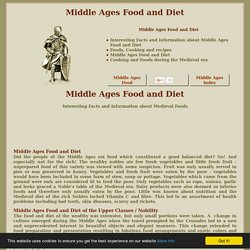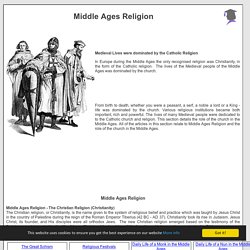

Clothing. Von Maur. Middle Ages Clothing. Elaborate Clothing. Diet. Veggies. Middle Ages Food and Diet. Interesting Facts and Information about Medieval Foods Middle Ages Food and DietDid the people of the Middle Ages eat food which constituted a good balanced diet?

No! And especially not for the rich! The wealthy nobles ate few fresh vegetables and little fresh fruit - unprepared food of this variety was viewed with some suspicion. Fruit was only usually served in pies or was preserved in honey. Middle Ages Food and Diet of the Upper Classes / NobilityThe food and diet of the wealthy was extensive, but only small portions were taken. Manchet breadA vast variety of meats and game including venison, beef, pork, goat, lamb, rabbit, hare, mutton, swans, herons and poultryFish - fresh and salt water fish.
Nutrisystem® - Official Site -Diet Plans, Weight Loss Programs, Diet Programs, Lose Weight. Offer Terms and Conditions †Free Fast 5 kit available with new 28-Day Auto Delivery program purchase only.

Not valid with Nutrisystem D program. Included with first order only. With Auto-Delivery, you receive a discount off the Full Retail Value and free shipping to Continental US only. With Auto-Delivery, you are automatically charged and shipped your 28-Day program once every 4 weeks unless you cancel. †† If you're not 100% satisfied, call 1-800-727-8046 within 14 days of delivery and send the remaining non-frozen food back for a full refund of your order. Religion. Middle Ages Religion. Middle Ages Religion - The Christian Religion (Christianity)The Christian religion, or Christianity, is the name given to the system of religious belief and practice which was taught by Jesus Christ in the country of Palestine during the reign of the Roman Emperor Tiberius (42 BC - AD 37).

Christianity took its rise in Judaism. Jesus Christ, its founder, and His disciples were all orthodox Jews. The new Christian religion emerged based on the testimony of the Scriptures, as interpreted by the life of Jesus Christ and the teaching of His Apostles, which were documented in the Bible. Bible. Carrie Underwood - Jesus, Take The Wheel. Medicine. Medical Education. Medieval Medicine. Education The practitioners of medicine in medieval Europe were both members of clergy and laymen.

The clergy was educated by the Church, while the laymen either attended universities or joined a medical guild. The people who would normally join the clergy or universities were the sons of nobility. Guilds, on the other hand, offered an attempt at creation of the middle class in medieval Europe. Guilds consisted of merchants, who were not noble born, and their children who had an opportunity to choose a different craft. The concept of the university had its origins in the Middle ages. The course of study was as follows: Students enter the university at the age of 14. Students in medieval universities experienced the same distractions in their lectures as students today, as seen by the students in this scene of a 14th century German classroom.
Guilds were efficient and selfish organizations that had as a goal the protection of interest of their respective members. Home. Money. Gold. Gold - during the Medieval Era - Part I. - la version française - la versíon española "Gold is of the metals the most precious.

" Geber. The fall of the Roman Empire in the west during the latter part of the fifth century was followed by widespread political and economic chaos that existed in Europe for more than four centuries (the Dark Ages) and was only slowly terminated by the institution of the feudal system in the ninth century. This social order passed into decline near the end of the thirteenth century and was gradually replaced during the next three centuries by nation-states with monarchical and nobility systems, coteries of salaried civil servants, and rudimentary parliaments. The social chaos, incessant warfare, plagues, and general economic instability during the Early Middle Ages (fifth to the eleventh centuries) resulted in a marked reduction in mining and placering operations for gold.
In central Europe the pagan Avars, Czechs, and Saxons mined gold in Bohemia, Transylvania, and the Carpathians. Of Sol, or Gold. How to Make Money Buying and Selling Gold.